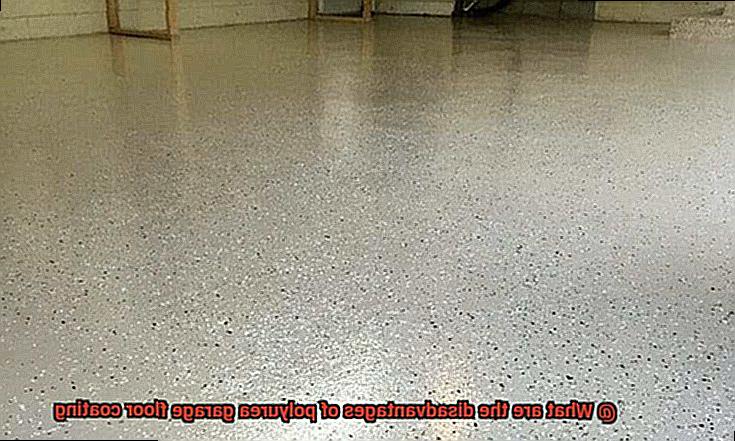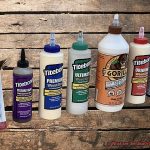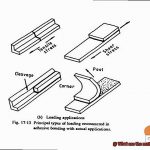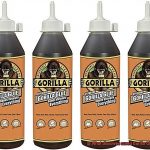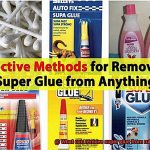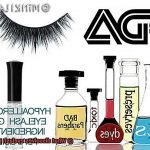When it comes to transforming your garage floor, the temptation to opt for polyurea coatings is hard to resist. Boasting unparalleled toughness and an ability to fend off chemicals, oils, and pesky scratches, polyurea has become a favorite among homeowners seeking durability and aesthetic appeal. Yet, as with any product, it’s crucial to weigh the cons alongside the pros.
In this blog post, we’ll uncover the potential disadvantages of polyurea garage floor coatings. We’ll explore limitations such as a restricted color palette, hefty upfront costs, and the necessity of professional application. By delving into these aspects head-on, we aim to equip you with all the necessary information to make an educated decision regarding your garage flooring needs. So let’s plunge into the realm of polyurea and uncover both its merits and limitations.
High Cost of Materials and Labor
Contents
- 1 High Cost of Materials and Labor
- 2 Prone to Yellowing Over Time
- 3 Poor Adherence to Certain Surfaces
- 4 Multiple Coats Require Longer Drying Times
- 5 Limited Customization Options
- 6 Sensitive to Temperature Fluctuations During Application Process
- 7 Emission of Strong Odors During Application and Curing Process
- 8 Not as Resistant to Certain Substances as Epoxy Coatings
- 9 Conclusion
Polyurea garage floor coating is highly regarded for its exceptional durability and longevity. However, one major drawback of this popular choice is its high cost, which includes both the expensive materials and skilled labor required for installation. In this article, we will delve into the reasons behind the elevated costs of polyurea garage floor coating and evaluate whether the benefits outweigh the price.
Materials:
Polyurea coatings stand out due to their advanced technology and special chemical compositions, providing superior protection against chemicals, abrasion, and heavy foot and vehicle traffic. These specialized materials come at a premium compared to other coatings such as epoxy or acrylic, contributing to the higher cost.
Labor:
Installing polyurea garage floor coatings demands experienced professionals who are well-versed in working with these specialized materials. Surface preparation, including meticulous cleaning, crack repairs, and primer application, can be labor-intensive and time-consuming. As a result, the overall cost of the project increases significantly.
Quick Curing Time:
One factor that adds to the high cost of polyurea garage floor coating is its rapid curing time. Installers must work swiftly and efficiently to ensure proper application before the coating starts to cure. This necessitates skilled labor, further elevating the overall cost.
Long-Term Benefits:
Considering the long-term benefits is crucial when evaluating the high cost of polyurea garage floor coating. Its exceptional durability and resistance to chemicals, stains, and abrasion significantly extend the lifespan of garage floors, reducing the need for frequent repairs or replacements. This leads to potential cost savings over time.
Prone to Yellowing Over Time
However, there is one significant drawback to these coatings: they are prone to yellowing over time. In this article, we will delve into the reasons behind this phenomenon and explore effective strategies to mitigate it.
The Fading Factor: UV Radiation
Exposure to UV radiation from the sun is one of the primary causes of yellowing in polyurea coatings. Over time, the sun’s potent rays break down the chemical bonds within the coating, resulting in a loss of its original color and the development of a yellowish tint. To combat this issue, manufacturers have developed formulations with improved UV resistance to minimize yellowing.
Unwanted Color Transformations: Chemical Reactions
Polyurea coatings can also undergo color changes due to chemical reactions with specific substances. Harsh cleaning agents or solvents containing aggressive chemicals can react with the coating and alter its color. To prevent exacerbating this issue, it is crucial to use mild cleaners when maintaining polyurea-coated garage floors.
The Inevitable Process: Natural Aging
Even without external factors, polyurea coatings may naturally age, resulting in yellowing over time. As the coating matures, it gradually loses its original appearance and develops a yellowish hue. While this aging process is inevitable, regular maintenance and proper care can help slow down this deterioration.
Considerations When Choosing Polyurea Coatings:
When selecting a garage floor coating, it is essential to take yellowing into account. While some may argue that yellowing is purely cosmetic and does not affect performance, it is still a factor worth considering. Researching and choosing a high-quality polyurea product with improved UV resistance and color stability can significantly reduce the risk of yellowing.
Maintenance: Preserving the Coating’s Beauty
To prolong the lifespan and maintain the appearance of a polyurea garage floor coating, regular cleaning using mild cleaners is crucial. Avoiding exposure to harsh chemicals and applying a protective topcoat or sealer can provide an extra layer of defense against yellowing and other forms of deterioration.
Poor Adherence to Certain Surfaces
It can be frustrating and disappointing to invest time and money into a coating job, only to see it peel off or delaminate over time. In this article, we will explore the potential causes of poor adherence when applying polyurea garage floor coatings and provide valuable insights on how to avoid this issue.
Moisture and Contaminants:
One of the primary culprits behind poor adherence is the presence of moisture or contaminants on the surface. Before applying polyurea coating, it is essential to ensure that the surface is clean, dry, and free from any dirt, oil, grease, or other substances that may hinder proper adhesion.
Moisture can create a barrier between the coating and the surface, preventing them from bonding effectively. Additionally, contaminants like dirt or grease can interfere with the chemical reaction that allows the polyurea to adhere to the surface.
Challenging Surfaces:
Certain surfaces pose a greater challenge for polyurea to adhere to. Smooth or non-porous surfaces like tiles or polished concrete can be particularly tricky. In such cases, additional preparation steps may be required, such as roughening the surface or applying a primer, to enhance adhesion.
Roughening the surface creates more texture for the polyurea to grip onto, while a primer provides an extra layer of adhesion-promoting material.
Temperature and Humidity:
Temperature and humidity conditions during the application process can also impact adherence. Extreme temperatures or high humidity levels can affect the curing process of polyurea, leading to weak bonds between the coating and the surface.
It is crucial to follow the manufacturer’s guidelines regarding temperature and humidity requirements for optimal results.
Applying polyurea in ideal temperature and humidity conditions ensures proper curing, resulting in a strong and durable bond.
Chemical Interference:
Chemicals or substances present on the surface can also interfere with adhesion. If the floor has been previously coated with epoxy or other types of sealants, thorough removal is necessary before applying polyurea to ensure proper bonding.
Chemical residue from previous coatings can create a barrier between the polyurea and the surface, preventing them from adhering effectively.
Long-Term Factors:
Poor adherence may not always become apparent immediately after application but can manifest over time due to heavy traffic, exposure to harsh chemicals, or frequent temperature fluctuations.
Regular maintenance and care are essential to prevent peeling or delamination of the coating. Avoid using harsh chemicals that can degrade the coating over time and promptly clean up spills to prevent any damage.
Multiple Coats Require Longer Drying Times
When it comes to applying multiple coats of polyurea, the drying time can be significantly longer. This is due to the crucial process of curing and drying that each layer of polyurea coating needs to undergo before the next coat can be applied.
To understand why multiple coats require longer drying times, think of it as building a solid foundation for a house. Just like you need to let each layer dry before adding another layer on top, each coat of polyurea needs time to fully cure and dry in order to ensure proper adhesion and durability of the coating.
The drying time can vary depending on several factors, including temperature, humidity, and the thickness of the coating. In some cases, it may take several hours or even days for each coat to dry completely before another coat can be added. This longer drying time can be frustrating for those seeking a quick and efficient way to coat their garage floors.
However, there are steps you can take to make the process smoother. First and foremost, it is essential to follow the manufacturer’s instructions and guidelines regarding drying times between coats. The manufacturer knows their product best and will provide the most accurate information on drying times.
Patience is also key. Rushing the process by applying another coat before the previous one is fully dried can lead to poor adhesion and compromised durability of the coating. It may seem like a small inconvenience to wait for each coat to dry thoroughly, but it is worth it for a high-quality finish that will last.
Limited Customization Options
Today, we embark on another journey into the world of polyurea garage floor coatings. While we have previously extolled their numerous benefits, it is time to shed light on a potential downside: limited customization options. Like a brushstroke missing from a masterpiece, this limitation can leave some homeowners and business owners feeling unsatisfied. Let us delve deeper into the reasons behind this limitation and explore its impact.
Aesthetic Preferences:
Polyurea coatings, unlike their epoxy or concrete stain counterparts, come with a narrower range of colors and finishes. This can be disheartening for those who seek to personalize their garage floors, transforming them to match their unique aesthetic preferences or even their brand identity. After all, your garage is an extension of your personality.
Limited Choices:
While some companies offer a few color options for polyurea coatings, these choices are often limited. It is essential to cater to the specific needs and desires of each individual. Unfortunately, this limitation might not live up to everyone’s expectations or allow for true self-expression.
Lack of Intricate Designs:
The application process for polyurea coatings is known for its efficiency and speed, leaving little time for incorporating intricate designs or patterns into the coating. This absence of detailed customization options might disappoint those craving a more captivating and eye-catching look for their garage floors—a missed opportunity to showcase their individuality.
Future Alterations:
Imagine desiring a change in color or design for your polyurea-coated floor in the future. Regrettably, altering or removing polyurea coatings can be quite challenging. They boast remarkable resistance to removal or alteration, necessitating the complete removal of the existing coating and application of a new one—a time-consuming and costly endeavor.
Conclusion:
While polyurea garage floor coatings offer exceptional durability and chemical resistance, it is crucial to acknowledge the limitations that come with limited customization options. For those who yearn for a truly personalized and distinctive look for their garage floors, exploring other coating options might be a more suitable choice. However, if durability and resistance are your primary concerns, polyurea coatings still remain a reliable option for protecting your garage floor.
Sensitive to Temperature Fluctuations During Application Process
When it comes to polyurea garage floor coatings, durability and resistance to chemicals are often the first characteristics that come to mind. However, there is one crucial factor that can make or break the application process – temperature fluctuations. These coatings are highly sensitive to temperature changes during application, and understanding why this matters is key to achieving a successful finish.
Applying polyurea coatings involves a spray application method that necessitates precise temperature control for proper curing and adhesion. The consequences of incorrect temperatures can be significant. If the temperature is too low during application, the coating may not cure properly, resulting in a weakened and less durable finish. Conversely, if the temperature is too high, the coating may cure too quickly, leading to bubble formation and surface imperfections.
Finding the optimal temperature range for polyurea coating application can be quite challenging, especially in regions with extreme weather conditions. To ensure a successful application, various temperature control measures may need to be employed. This could include heating or cooling the substrate and adjusting the application environment accordingly. Applicators must diligently monitor and adjust the temperature throughout the process to achieve optimal results.
Even after the polyurea coating has cured, it remains sensitive to temperature changes. Extreme fluctuations in temperature, such as rapid heating or cooling of the coated surface, can cause the coating to expand or contract. This can lead to cracking or delamination over time if not properly addressed.
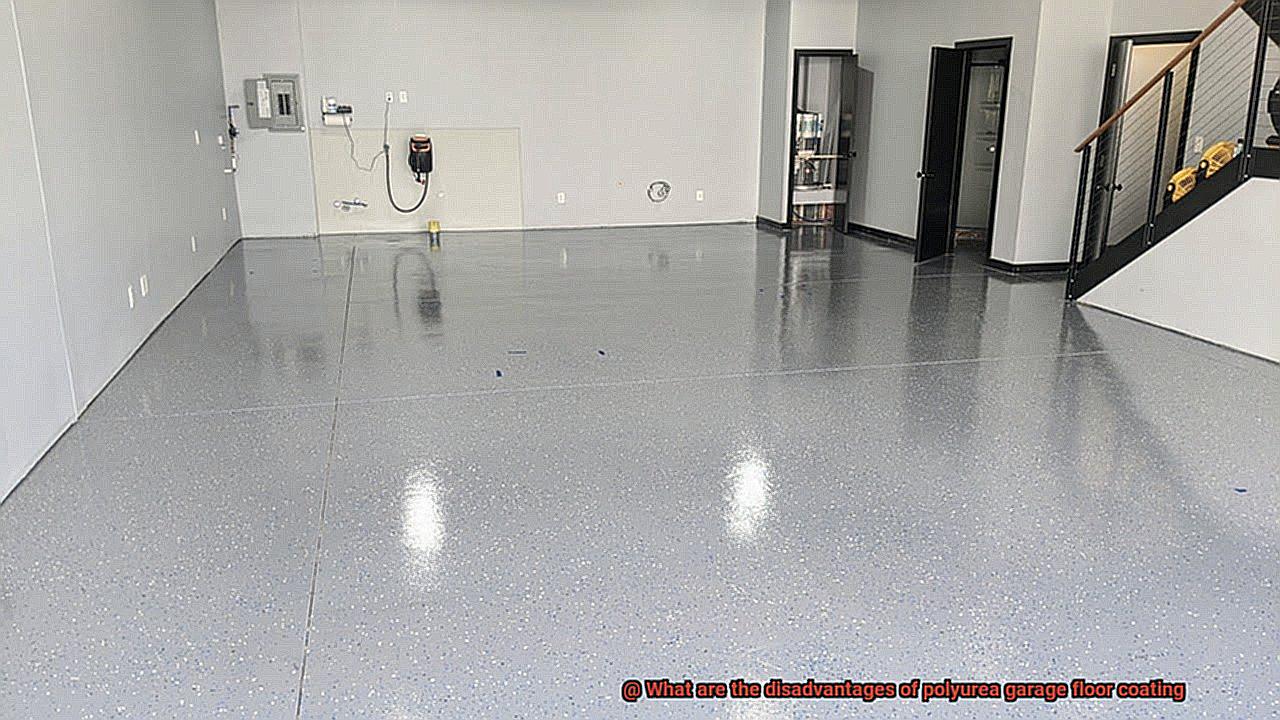
To protect your polyurea-coated garage floors from these issues, it is recommended to take preventive measures. Avoid placing hot objects directly on the surface, as this can cause localized heating and potential damage. Additionally, be mindful of subjecting the coating to freezing temperatures, as rapid cooling can lead to contraction and subsequent cracking.
Emission of Strong Odors During Application and Curing Process
Revitalizing your garage floor with a polyurea coating is an excellent choice for durability and chemical resistance. However, it’s important to be prepared for the strong odors that may accompany the application and curing process. Understanding why these odors occur and implementing strategies to minimize their impact can help ensure a successful renovation.
Why the Stink?
Polyurea garage floor coatings consist of two components – an isocyanate and a resin. When these components mix during application, a chemical reaction takes place, releasing volatile organic compounds (VOCs). These VOCs are responsible for the strong odors that can make your eyes water and your nose wrinkle.
The Curing Process:
After application, the polyurea coating needs time to cure and form a solid film on the surface. During this process, the release of VOCs continues, resulting in lingering odors. The length of the curing period varies depending on factors like temperature and humidity but typically lasts several days to a week.
Ventilation is Key:
To combat the stench, proper ventilation is crucial. Open windows, turn on fans, and allow fresh air to circulate. Increased airflow accelerates the dissipation of odors, reducing their concentration in the area.
Safety First:
While the odors may be unpleasant, it’s essential to note that they are not harmful when appropriate safety precautions are taken. Wearing gloves, goggles, and respiratory masks protects against potential irritants and ensures a safe working environment.
Low VOC or Odorless Options:
For individuals sensitive to strong smells, some manufacturers offer low VOC or odorless formulations of polyurea coatings. These alternatives minimize the emission of strong odors while maintaining the same level of durability and performance.
Not as Resistant to Certain Substances as Epoxy Coatings
When it comes to revamping your garage floor, two popular options you may have come across are polyurea and epoxy coatings. While both offer durability and protection, there are some differences to consider when it comes to resistance to certain substances.
Epoxy coatings have long been hailed as the gold standard in garage floor coatings due to their exceptional resistance to a wide range of chemicals, including gasoline, oil, and other automotive fluids. These coatings create a strong barrier that prevents these substances from seeping into the concrete and causing damage. If you work with or store these substances in your garage, epoxy coatings may be the better choice for you.
Polyurea coatings, on the other hand, may not provide the same level of resistance to certain substances as epoxy coatings. While they still offer some resistance, they may not be as effective at preventing penetration and damage from chemicals and fluids. This can be a disadvantage for those who have a higher risk of spills and splashes or plan on using harsh chemicals in their garages.
One reason why some coatings may not be as resistant as epoxy coatings is that certain chemicals can react with polyurea coatings and cause them to degrade or break down over time. Strong solvents or acids, for example, can cause the coating to soften or become discolored. Additionally, polyurea coatings may not be as resistant to hot tire marks compared to epoxy coatings. The heat from hot tires can cause the polyurea coating to soften or even melt, resulting in unsightly marks or damage.
To mitigate these disadvantages, it’s important to promptly clean up any spills or leaks on a polyurea-coated surface. Avoid using harsh solvents or acids that could potentially damage the coating. Using mats or protective pads under vehicles can also help prevent hot tire marks.
While polyurea coatings offer many benefits like fast curing times and high durability, it’s crucial to carefully assess your specific needs before making a decision. Consider the substances you work with and the potential risks of spills or splashes in your garage. If chemical resistance is a top priority for you, epoxy coatings may be the better choice.
nfPCFYxUntY” >
Conclusion
In conclusion, polyurea garage floor coatings offer exceptional durability and chemical resistance, but they do come with a few drawbacks that should be considered.
Firstly, the high cost of materials and labor is a major disadvantage. Specialized materials and skilled professionals are required for installation, which significantly increases the overall project cost. However, the long-term benefits of durability and reduced maintenance costs may outweigh this initial investment.
Another drawback is the potential for yellowing over time. UV radiation, chemical reactions, and natural aging can cause polyurea coatings to turn yellow. While some formulations have improved UV resistance, it’s still something to consider when choosing a coating option.
Poor adherence to certain surfaces is also a downside. Moisture, contaminants, temperature, and previous coatings can interfere with proper adhesion. Thorough surface preparation and following manufacturer guidelines are crucial for a strong bond between the coating and the surface.
The application process for multiple coats of polyurea can be time-consuming due to longer drying times between coats. Patience and following instructions are key for achieving a high-quality finish.
Limited customization options may disappoint those seeking a personalized look for their garage floors. Polyurea coatings come in a narrower range of colors and finishes compared to epoxy or concrete stain options.
Polyurea coatings are sensitive to temperature fluctuations during application, which can affect curing and adhesion. Proper temperature control measures must be taken throughout the process for optimal results.
Strong odors emitted during application and curing due to volatile organic compounds (VOCs) can be unpleasant. Proper ventilation and safety precautions should be implemented to minimize their impact.
Lastly, polyurea coatings may not be as resistant to certain substances as epoxy coatings. Epoxy offers superior resistance against chemicals like gasoline or oil, making it a better choice for those at higher risk of spills or splashes.
In conclusion, although polyurea garage floor coatings have their disadvantages, they still remain a reliable option for protecting your garage floor.

